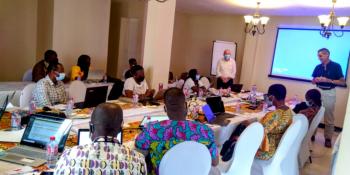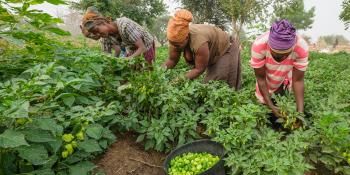In Kaolack, community radio broadcasters help spread climate information

The use of climate information by rural stakeholders is one of the conditions for their adaptation to climate change.
The Sahel is the only place in the world where climate variability is extremely high in all weather conditions and impacts heavily on agricultural production. It has therefore become imperative for farmers in the Sahel to use climate information to adapt to the changing climate. This information is out there, and farmers need it. Consequently, it needs to be made accessible and understandable for them: this is the role that employees of community radios would like to play. These professionals, who process and disseminate information, are key allies in the adaptation to climate change.
The National Civil Aviation and Meteorology Agency (ANACIM) of Senegal is well aware of this situation, and therefore organized a training course from 14 to 16 August to initiate employees of the Association and Community Radios Union (URAC) into understanding climate information and assuming ownership of the newsletters available.
We wish to attain a stage in agriculture where we can use climate information intelligently and efficiently” says Ousmane Ndiaye.
To attain this stage, CCAFS-West Africa Programme has undertaken several initiatives with its partner, ANACIM.
The initiatives are intended to facilitate access for West African small farmers to agro-climatic data, and develop their ability to understand and use the data to enhance decision-making in farming.
The initiatives implemented with other agencies such as the Department of Agriculture and other local institutions and farmer organizations are, in light of the results, showing how climate information services can revolutionize agriculture.
Skills training
Ousmane Ndiaye believes that community radio is one of the most effective ways of reaching rural communities, who are more exposed to the effects of climate hazards than other people. The radio, which is the most used information medium in rural areas, is a very well established network almost everywhere and is very close to the people.
He is also convinced that this medium can "play a key role in disseminating climate information at the right time and in plain language that is accessible to users”.
That is why the training was designed to achieve the set goals. It focused on the following modules: weather observation, the basis of forecasts and its uncertainties, the scope of meteorology, climate change, measuring rainfall, ANACIM weather reports and the monitoring and evaluation of planned activities. Furthermore, 34 radio stations across the country were able to participate in the training.
According to Talla Dieng, President of the Rural Radios Network (URAC), this training
came at the right time because it helps us to enhance the content of our broadcasts on the environment and be of public utility in relaying climate information in real time to the grassroots population. In addition, we were given rain gauges that have also enabled us to be actors because we no longer need to call to find out the amount of rainfall in our area. We hope that other radio stations will be given the opportunity to receive such training."
At the end of the workshop, a monitoring process was put in place to assess the effective dissemination of climate information.
Watch Video: Climate information in Kaffrine, Senegal
On the same subject…
What can be done to address climate change in West Africa?
Seasonal climate forecasts of scientists in line with those of “saltigués” in Senegal
This blog has drawn on the article posted on the Senegalese Press Agency site.
Ousmane Ndiaye works with the National Civil Aviation and Meteorology Agency of Senegal; Sekou Toure works as Communication Officer at CCAFS- West Africa Programme.


